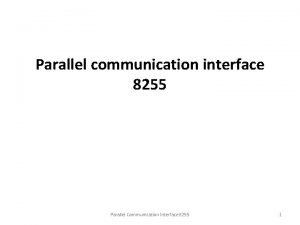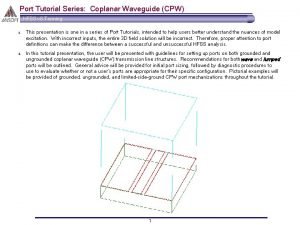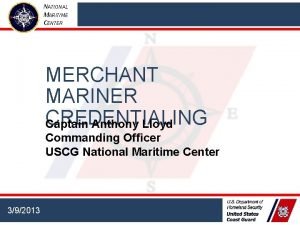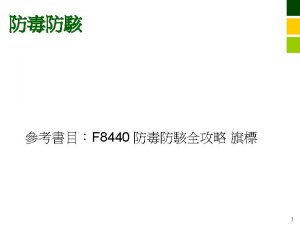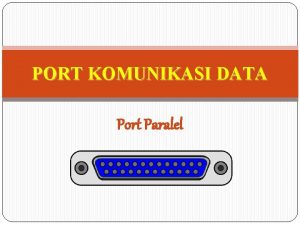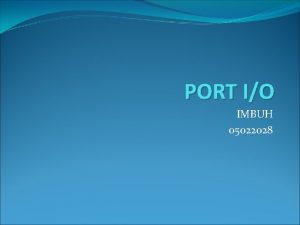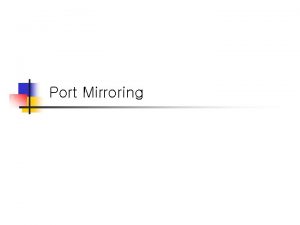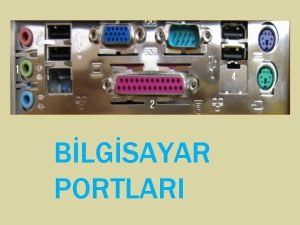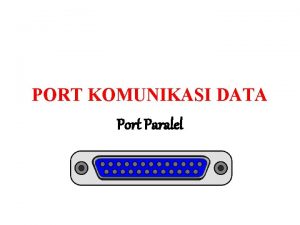National Institute of Maritime Port and Aviation Technology












- Slides: 12

National Institute of Maritime, Port and Aviation Technology Electronic Navigation Research Institute ICAO Frequency Spectrum Management Panel (FSMP) 10 th Working Group Meeting, Virtual Meeting, August 2020 Interference Path Loss Measurement at Wireless Avionics Intra-Communication Band using Beechcraft B 300 Aircraft S. Futatsumori Electronic Navigation Research Institute 2020/08

Contents Aircraft under measurement Ø Specification of onboard radio altimeter Interference path loss (IPL) measurement conditions Ø Measurement set-up and overview Ø Antenna locations Measurement results Ø Inside cabin Ø Outside cabin 2/12 National Institute of Maritime, Port and Aviation Technology Electronic Navigation Research Institute 2020/08

Aircraft under measurement Beechcraft B 300(King Air B 350) 3/12 National Institute of Maritime, Port and Aviation Technology Electronic Navigation Research Institute 2020/08

Radio altimeter FMCW radio altimeter Transmitting antenna Receiving antenna Manufacture Model Center frequency Bandwidth Transmitting power Ranging method Antenna gain 4/12 Rockwell Collins ALT-1000 4. 3 GHz 100 MHz 27 d. Bm FMCW 9. 5 d. Bi (Linear polarization) National Institute of Maritime, Port and Aviation Technology Electronic Navigation Research Institute 2020/08

Measurement set-up IPL measurement set-up Ø The path loss between the transmitting antenna and the receiving antenna are measured using the signal generator and spectrum analyzer. The number of the antenna location is 20 points (outside cabin) and 17 points (inside cabin). Ø IPL measurements are carried out based on the procedure described in DO 307 A - Aircraft Design and Certification for Portable Electronic Device (PED). Ø The all cable loss, transmitting antenna return loss are calibrated at IPL calculation. Transmitting antenna (Standard dipole antenna) Signal generator (Rhode&Schwarz SMB 100 A) Spectrum analyzer (Keysight technologies N 9912 A) Pass loss Widows Computer 5/12 Receiving antenna (radio altimeter antenna) Ethernet 100 BASE-T National Institute of Maritime, Port and Aviation Technology Electronic Navigation Research Institute 2020/08

Overview of measurement Conditions Ø Location and date: Sendai Airport, 5 th August 2019 Ø Tarmac conditions: dry Ø Measurement frequency band: 4, 000 MHz-4, 600 MHz (201 points) Ø Transmitting antenna: Standard dipole antenna Ø Transmitting antenna polarization: three orthogonal axis Ø Measurement dynamic range: Approximately 120 d. B Beechcraft B 300 6/12 National Institute of Maritime, Port and Aviation Technology Electronic Navigation Research Institute 2020/08

Antenna location Inside cabin: 17 points Outside cabin: 20 points A B Q R C ST A D F E G H J I K L 7/12 M N O P Q D E H I F G J K L M B C Radio altimeter receiving antenna (bottom of the fuselage, 10 cm offset to center) N O P National Institute of Maritime, Port and Aviation Technology Electronic Navigation Research Institute 2020/08

Measurement results: inside cabin 1 No Transmitting antenna location IPL minimum (d. B) IPL median (d. B) A Cockpit (center) 81. 0 91. 3 B Cockpit (left seat) 79. 7 89. 3 C Cockpit (right seat) 79. 2 88. 9 D Left window (2 nd row) 83. 7 95. 2 E Right window (3 rd row) 81. 7 94. 4 F Left window (3 rd row) 83. 9 94. 8 G Left window (4 th row) 82. 9 91. 2 H Left window (5 th row) 79. 6 90. 1 D I Right window (6 th row) 72. 8 85. 5 F J Left window (6 th row) 78. 8 89. 5 G K Left window (7 th row) 77. 8 89. 9 H 75. 8 87. 5 J 74. 9 88. 1 K 83. 2 93. 2 L M N O P Q L M N Left window (8 th Right window row) (8 th row) Cabin door (9 th O Right window row) 78. 8 88. 2 P Left window (10 th row) 82. 0 92. 5 Q Q: Right window (10 th row) 82. 5 91. 9 Total 72. 8 90. 9 A B C E I Radio altimeter receiving antenna 8/12 National Institute of Maritime, Port and Aviation Technology Electronic Navigation Research Institute 2020/08

Measurement results: inside cabin 2 IPL probability 8 IPL minimum: 72. 8 d. B Probability (%) 7 6 IPL median: 90. 9 d. B 5 4 3 2 1 0 50 60 70 80 90 100 Interference pass loss (d. B) 110 120 130 Total measurement data 132, 660 points: 20 (transmitting antenna location) x 201 (Frequency domain) x 11 (time domain) x 3 (transmitting antenna axis) 9/12 National Institute of Maritime, Port and Aviation Technology Electronic Navigation Research Institute 2020/08

Measurement results: outside cabin 1 No Transmitting antenna location IPL minimum (d. B) IPL median (d. B) A Nose radome 74. 8 83. 5 B Left wingtip (outside) 80. 1 93. 3 C Left wingtip (inside) 70. 8 85. 7 D Left engine (forward outside) 79. 0 90. 4 E Left engine (forward inside) 60. 0 76. 8 F Left engine (back outside) 81. 7 93. 7 G Left engine (back inside) 75. 2 86. 2 H Right engine (forward inside) 63. 2 75. 6 I Right engine (forward outside) 75. 7 90. 7 J Right engine (back inside) 70. 6 83. 0 D E H I K Right engine (back outside) 81. 0 96. 3 F G J K L Right wingtip (inside) 65. 7 86. 2 M Right wingtip (outside) 76. 0 93. 6 N Left rear fuselage 67. 2 78. 3 O Right rear fuselage 66. 0 80. 0 P Tail 70. 8 84. 3 Q Nose landing gear light 73. 7 81. 9 R Nose landing gear 73. 9 86. 1 S Main landing gear (right) 55. 0 64. 9 T Main landing gear (left) 61. 4 75. 1 Total 55. 0 89. 4 10/12 National Institute of Maritime, Port and Aviation Technology Q R ST A L M B C N O P Radio altimeter receiving antenna Electronic Navigation Research Institute 2020/08

Measurement results: outside cabin 2 IPL probability 8 Probability (%) 7 6 IPL median: 89. 4 d. B IPL minimum: 55. 0 d. B 5 4 3 2 1 0 50 60 70 80 90 100 Interference pass loss (d. B) 110 120 130 Total measurement data 112, 761 points: 17 (transmitting antenna location) x 201 (Frequency domain) x 11 (time domain) x 3 (transmitting antenna axis) 11/12 National Institute of Maritime, Port and Aviation Technology Electronic Navigation Research Institute 2020/08

Conclusions Ø IPL of Beechcraft B 300 aircraft is measured at WAIC frequency band. The minimum IPL with the transmitting antenna inside cabin was 72. 8 d. B, which was not to small compared with that of Airbus A 321(74. 4 d. B)*. *ACP-WGF 29/IP 13, "Interference Path Loss Measurements in the Radio Altimeter Band onboard an Airbus A 321", Sep. 2013. The minimum IPL with the transmitting antenna outside cabin was 55. 0 d. B, which was measured with almost line of sight conditions and 3 m distance. Even if the transmitting antenna and the radio altimeter antenna are close, minimum IPL more than 65 d. B is obtained with non line of sight conditions. Future works Ø 12/12 We will carry out additional measurements employing other measurement parameters. National Institute of Maritime, Port and Aviation Technology Electronic Navigation Research Institute 2020/08
 Nmit.edu.my
Nmit.edu.my Spike unist
Spike unist National institute of standards and technology
National institute of standards and technology Assistive technology implementation plan
Assistive technology implementation plan National institute of agricultural technology
National institute of agricultural technology Unk global maritime institute
Unk global maritime institute Unk global maritime institute
Unk global maritime institute 8255 features
8255 features In bsr mode
In bsr mode Hfss wave port tutorial
Hfss wave port tutorial World maritime technology conference
World maritime technology conference National maritime single window
National maritime single window National maritime center
National maritime center








